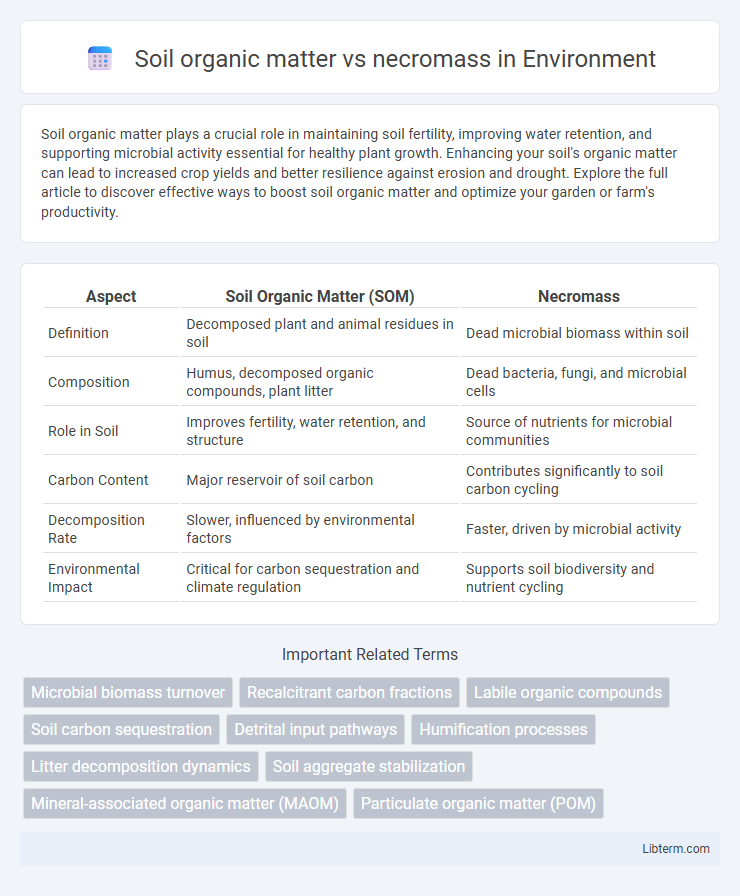Soil organic matter plays a crucial role in maintaining soil fertility, improving water retention, and supporting microbial activity essential for healthy plant growth. Enhancing your soil's organic matter can lead to increased crop yields and better resilience against erosion and drought. Explore the full article to discover effective ways to boost soil organic matter and optimize your garden or farm's productivity.
Table of Comparison
| Aspect | Soil Organic Matter (SOM) | Necromass |
|---|---|---|
| Definition | Decomposed plant and animal residues in soil | Dead microbial biomass within soil |
| Composition | Humus, decomposed organic compounds, plant litter | Dead bacteria, fungi, and microbial cells |
| Role in Soil | Improves fertility, water retention, and structure | Source of nutrients for microbial communities |
| Carbon Content | Major reservoir of soil carbon | Contributes significantly to soil carbon cycling |
| Decomposition Rate | Slower, influenced by environmental factors | Faster, driven by microbial activity |
| Environmental Impact | Critical for carbon sequestration and climate regulation | Supports soil biodiversity and nutrient cycling |
Introduction to Soil Organic Matter and Necromass
Soil organic matter (SOM) consists of decomposed plant and animal residues, microorganisms, and humic substances that enhance soil fertility, structure, and water retention. Necromass refers specifically to the biomass of dead microbial cells contributing significantly to SOM stabilization and nutrient cycling. Understanding the dynamics between SOM and necromass is crucial for improving soil health and carbon sequestration strategies.
Defining Soil Organic Matter
Soil organic matter (SOM) encompasses all organic components within the soil, including living microorganisms, plant and animal residues in various stages of decomposition, and stable organic compounds known as necromass. Necromass specifically refers to the accumulated dead microbial biomass that contributes to long-term soil carbon storage and nutrient cycling. Defining SOM involves understanding its complex composition, which plays a critical role in soil fertility, structure, water retention, and ecosystem productivity.
Understanding Necromass in Soil Ecosystems
Necromass in soil ecosystems refers to the pool of dead microbial biomass and plant residues that serve as a crucial source of nutrients and energy for soil organisms, distinct from living soil organic matter which includes active biological components. Unlike total soil organic matter, necromass tends to be more stable and contributes significantly to carbon sequestration by transforming into humus-like substances through microbial decomposition. Quantifying necromass provides insights into soil health, nutrient cycling, and the overall functionality of terrestrial ecosystems.
Composition Differences: Soil Organic Matter vs Necromass
Soil organic matter primarily consists of decomposed plant and microbial residues, including humus, carbohydrates, lipids, and proteins, while necromass refers specifically to the non-living microbial biomass remaining after cell death. The composition of necromass is richer in microbial cell wall components like peptidoglycan and chitin, which contribute significantly to soil carbon stabilization. Soil organic matter exhibits greater heterogeneity due to inputs from diverse sources, whereas necromass is a more defined subset dominated by microbial-derived carbon compounds.
Roles in Soil Fertility and Structure
Soil organic matter (SOM) enhances soil fertility by improving nutrient availability, water retention, and microbial activity, while necromass, consisting of dead microbial biomass, provides a vital source of stable carbon that contributes to long-term soil structure and carbon sequestration. Necromass forms a significant portion of soil organic carbon, influencing soil aggregation by acting as a binding agent for soil particles, thereby promoting soil porosity and aeration. Both SOM and necromass play complementary roles in sustaining soil health, with SOM driving active nutrient cycling and necromass ensuring structural integrity and resilience against erosion.
Decomposition Pathways and Microbial Processes
Soil organic matter comprises living and decomposed organic components, whereas necromass specifically refers to dead microbial biomass and residues. Decomposition pathways involve enzymatic breakdown of plant litter and necromass, facilitated by microbial processes such as mineralization and humification. Microbial activities regulate nutrient cycling, with necromass serving as a key substrate influencing carbon stabilization and soil fertility.
Effects on Carbon Cycling and Sequestration
Soil organic matter (SOM) significantly influences carbon cycling by serving as a reservoir for carbon storage, enhancing soil fertility, and promoting microbial activity that drives nutrient turnover. Necromass, the dead microbial biomass component of SOM, plays a critical role in stabilizing carbon within soil aggregates, thus facilitating long-term carbon sequestration. The interaction between SOM and necromass regulates carbon fluxes, affecting soil carbon stability and the potential for mitigating atmospheric CO2 through durable carbon storage.
Impacts on Nutrient Availability
Soil organic matter (SOM) enhances nutrient availability by releasing essential elements like nitrogen, phosphorus, and sulfur through microbial decomposition, which supports plant growth and soil fertility. Necromass, composed of dead microbial biomass, contributes significantly to stabilized soil organic carbon and acts as a slow-release reservoir of nutrients, improving long-term nutrient retention and cycling. The interaction between SOM and necromass regulates nutrient mineralization rates, influencing soil nutrient dynamics and overall ecosystem productivity.
Environmental and Agricultural Implications
Soil organic matter (SOM) enhances soil fertility, water retention, and microbial activity, directly supporting crop productivity and ecosystem resilience. Necromass, the dead microbial biomass within SOM, plays a crucial role in carbon sequestration and nutrient cycling, impacting greenhouse gas emissions and soil health. Understanding the balance between SOM and necromass informs sustainable agricultural practices that mitigate climate change and promote long-term soil sustainability.
Future Research Directions on Soil Organic Matter and Necromass
Future research on soil organic matter (SOM) and necromass should focus on quantifying the contributions of microbial necromass to overall SOM stocks across diverse ecosystems using advanced isotopic and molecular techniques. Developing mechanistic models that integrate microbial necromass dynamics with soil carbon cycling will improve predictions of carbon sequestration potential under changing land use and climate scenarios. Investigating the interactions between necromass, mineral-associated organic matter, and soil microbial communities will provide insights into stabilizing mechanisms critical for long-term carbon storage.
Soil organic matter Infographic

 libterm.com
libterm.com